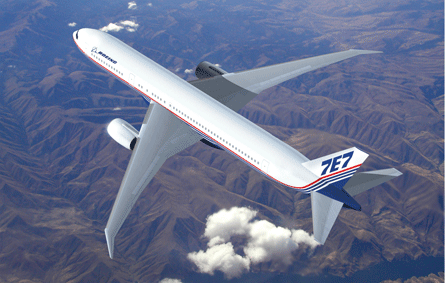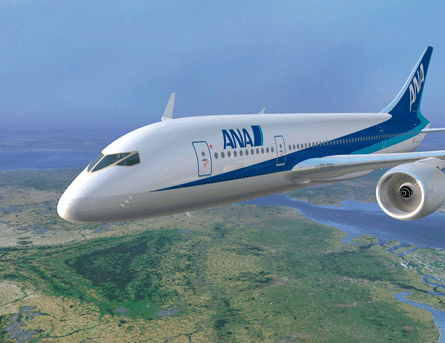The 787 is different - not least because Boeing decided to rewrite the rules of aircraft exterior design for its new twinjet, and called on a marketing guru for inspiration
Like any commercial airliner, the Boeing 787 was designed to rigid performance specifications. The aircraft must haul a certain amount of passengers, baggage and freight for a specific distance within a limited cost, and all engineering decisions are usually bound by that reality.
Boeing, however, was ready to challenge the dominance of such functional thinking with the 787, and - with little public acknowledgement to date - invented a new process for shaping how an aircraft is designed.
With the help of French-born marketing guru Clotaire Rapaille and a little open-mindedness at the top of Boeing's engineering establishment, a team led by Blake Emery, director of differentiation strategy, established a new set of rules for designing aircraft exteriors that seek to balance the needs of form and function.
"I think it has contributed to the market success of the Dreamliner," Emery says. "I hope that it is a process that is continued. So far it looks to me that that's the direction that it's taking."
|
|---|
The exterior of Boeing's 787 was designed using a new set of rules aimed at giving more weight to its looks than previous aircraft. |
With Boeing already looking beyond the 787 to a single-aisle fleet replacement or perhaps a refresh of the 777, Emery admits to worries that a new generation of Boeing executives may not embrace the formula used on the 787. "My fear is, my gosh, is there going to be anyone left who remembers we did it this way?" he asks, but adds: "So far, that fear on my part appears to be pretty groundless."
NEW GROUND BROKEN
Aircraft interiors have always been a domain for balancing the demands of style comfort for the passengers and the ruthless efficiency desired by operators and aerodynamic engineers alike. But within Boeing the 787 broke new ground for extending those principles to the design of the aircraft's exterior.
"That was one of the areas that we thought would be ground-breaking," Emery says. "In fact I spent a lot of time in those early days working with engineers. One of my favourite quotes came from Buckminster Fuller: 'If it isn't beautiful, I know it's not right'."
In Emery's mind, the 787 also posed another challenge in terms of product differentiation. It would be important to provide visual cues that would stand the 787 apart from the product it was replacing - the 30-year-old 767.
The design of the 787 would be influenced to a much greater extent by ideas generated from typically marketing philosophies like product differentiation. The marketers would even brainstorm aerodynamic thoughts with the engineers.
POST SONIC CRUISER
Emery's team actually got started on the 7E7 in the aftermath of the Sonic Cruiser concept, which was in time to be able to influence some of the basic decisions that were made in the earliest designs. "We'd ask these really naive questions. A lot of the engineers would kind of automatically say, 'no, you can't change that and you're dumb for even asking', but some of the leaders in place at the time really wanted to listen and see where it would go," Emery says.
But taking a new design approach required another ground-breaking step for Boeing's design team: seeking outside help. There was a need for an external voice that could help Boeing think through the challenges of tailoring an aircraft design that could not only meet the financial expectations of airlines, but also the visual sensibilities of the passengers who board the aircraft.
Boeing acknowledges the design influence of Rapaille, whose most famous contribution to industrial design is perhaps his workwith motor manufacturer Chrysler on the PT Cruiser car. A self-described "social anthropologist", Rapaille works as a consultant for companies in a wide variety of industries.
According to Rapaille's ideas, consumers make decisions about purchases subconsciously through the "reptilian" part of the brain, which is imprinted at an early age with dominant themes like survival and comfort. Using this theory, he guides a company's marketing staff to find "the code" to unlocking the consumer's reptilian instincts.
For Folger's, a coffee maker, Rapaille is credited in the late 1980s with shifting the company toward an advertising theme that focused on the product's aroma rather than its quality. Companies use his studies and "discovery sessions," which reportedly cost $125,000 (€88,300) per session, to design products and advertising campaigns
Rapaille has had a long relationship with Boeing, dating at least to an acknowledged association with former chief executive Phil Condit, who was forced to retire in 2003. Rapaille's web site even quotes Emery for a marketing blurb: "The way people talk about the discovery process is kind of like being in love everything you look at suddenly seems more alive," Emery says.
Rapaille himself is not a designer and it is not possible to trace his influence on the design to any specific feature. But Rapaille's work can be credited with helping Boeing shape the process for starting to think about aircraft design in a new way, and, ultimately, redefining how the company makes design trade-offs.
KNOWLEDGE BASE
Rapaille had no official design role in the 787 programme. But his guidance was added to a general base of knowledge that helped Boeing's engineers reach the final result. Perhaps Rapaille's most significant contribution was conceptual. According to Boeing sources, Rapaille urged Boeing to adopt a bird-like design for the wings and a fish-like appearance for the fuselage "We have used him and his methodology to study many different things," Emery says. "It hasn't been limited to the 787."
|
|---|
The 7E7 began with a conventional look |
As Boeing developed its ideas for the 787's design, the team developed drawings to show to focus groups in a roadshow that visited different parts of the world. The goal was to invite public comment on all aspects of the 787's design from the cabin layout to the exterior. In an early experiment, Boeing sought to validate the value of Rapaille's marketing principles.
"That was one of the most fascinating times in my career," Emery says. "People pretty much thought I was nuts."
The exact process is considered proprietary by Boeing, but Emery says the experiment gave people an opportunity to look at a number of aircraft exteriors and choose the ones they liked best. It was a test to discover if Rapaille's theories that appeared to work so well in the automotive industry could be translated to the design of a commercial airliner, where engineering function has, since the dawn of the jet age, with few exceptions, trumped stylistic form.
STARTING POINT
At least one drawing presented to the test group was the antithesis of Rapaille's principles. The result: "That aircraft exterior - no one ever chose it," Emery says. "That was one of the things that Rapaille did for us. He kind of gave us a starting point."
Rapaille also served in the background as an on-call consultant as the design took shape. The company sent him pictures of the design as it evolved, Emery says, and asked for feedback.
Some of Rapaille's responses did yield cosmetic changes, as Rapaille bore a heavy influence in selecting the distinctive paint scheme for the 787's livery.
In the globe-trotting focus group sessions, Emery's team sought to identify general principles about what attracts people to the exterior of an aircraft. Participants in the sessions were shown dozens of pictures of different designs, and asked to select ones they liked.
"We started taking those pictures around to engineers," Emery says. "In this case you primarily have to deal with structural engineers and aero-engineers. The aero guys have to figure out what this thing is going to do for us in the windtunnel because you can't do things that will increase drag."
SHARK-TAIL DESIGN
One of the earliest results was the 787's original design for a distinctive, "shark-tail" vertical fin, which curved inward at the base of the fuselage and back outward at the tip of the fin.
The shark-tail design was removed within a year of its first appearance of publicly released 787 images in favour of a conventional look. But Emery explains now that the change was not made because of an aerodynamic deficiency.
In fact, the shark-tail "really wasn't a problem a problem from a pure aerodynamic standpoint", he says.
|
|---|
Stages in evolution...early concepts featured the "shark's fin" tail |
The issue with the shark-tail was a mechanical problem. The rudder must be able to sweep across a certain radius and the base of the trailing edge of the vertical fin interfered with that sweep, so the concept was scrapped.
|
|---|
Marketing guru Clotaire Rapaille helped Chrysler with the design of its PT Cruiser |
A more successful experiment of design focused on the 787's nose. After initially adopting a 777-based design, Boeing quickly made a complete departure in the 7E7 nose shape. Its distinctive downward-slope seemed to borrow more from Concorde than the 777, which a decade ago was considered within Boeing to be the pinnacle of efficient aerodynamic shaping.
When asked if it was assumed within Boeing that the 787 nose would simply be borrowed from the 777, Emery says: "You are very right in assuming that the 777 was initially seen as the standard in many, many cases about what the 787 was supposed to be. [But] a number of us were not really pleased with that as the standard. We felt we really needed to push much stronger than that."
Join in the Airspace discussion - Which one? Airbus A380 or Boeing 787
Source: Flight International























